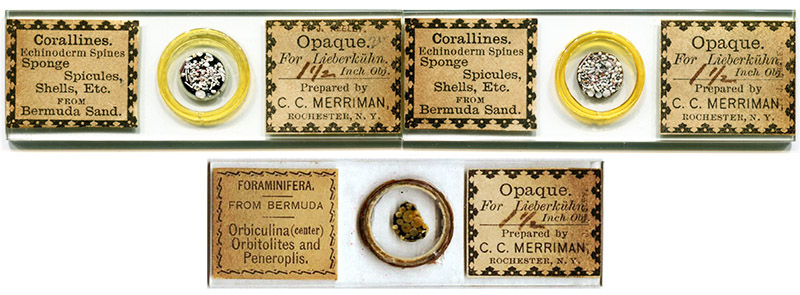
Corydon Charles Merriman, 1827-1908
by Brian Stevenson
last updated April, 2015
Generally known in records by his initials, C.C. Merriman was an avid amateur microscopist in the USA, primarily active between the mid-1860s through the late-1880s. His microscope slides appear to have been distributed through exchanges with other enthusiasts: there are no known records of Merriman selling his preparations, and evidence indicates that Merriman was wealthy enough to not need the extra money. Merriman mounted a variety of objects, which are generally very well-finished, and are attractive both with and without a microscope.

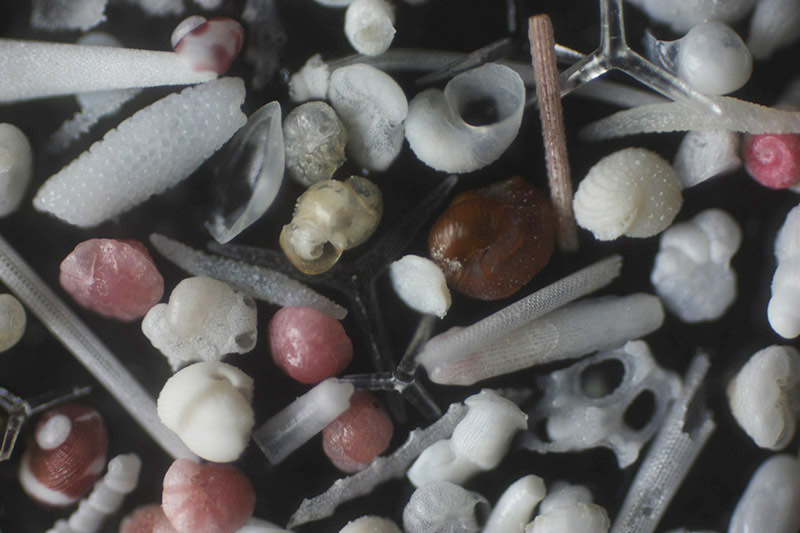
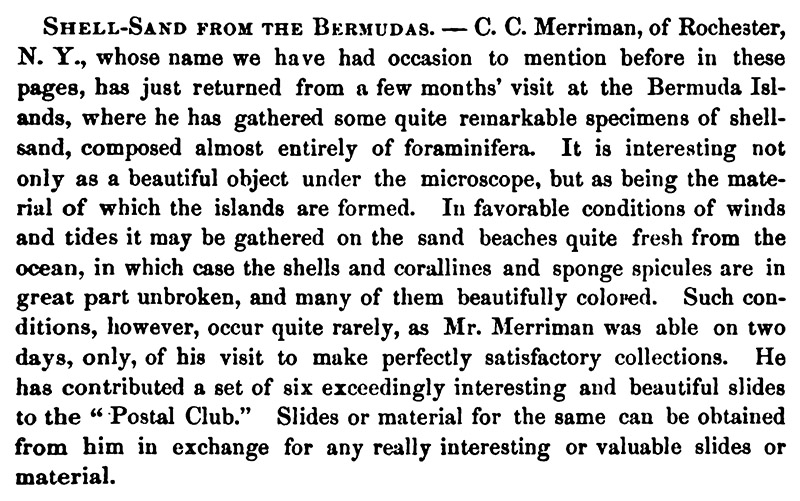

Figure 1.
Top, three examples of Merriman’s slides of material he collected in Bermuda during an 1877 holiday. Middle, detail of “corallines, echinoderm spines, sponge spicules, shells, etc. from Bermuda sand”. Bottom, an 1877 announcement that appeared in ‘The American Naturalist’ and an 1877 exchange offer from ‘The American Journal of Microscopy and Popular Science’.
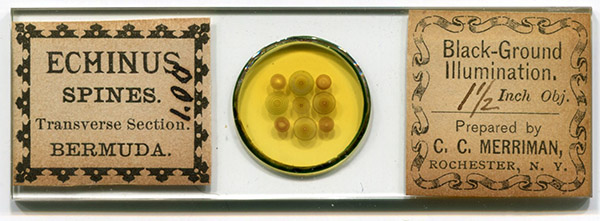
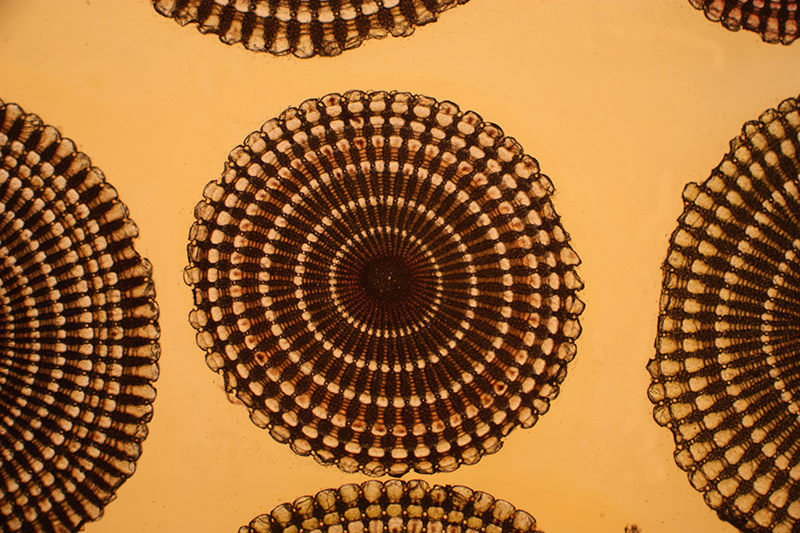
Figure 2.
Sections of echinus spines. At the 1884 Annual Soiree of the American Society of Microscopists, Merriman displayed this or a similar slide under a “Beck’s binocular” microscope. In Merriman’s 1885 “Lectures”, he wrote, “By request is here published the author's method of cutting and grinding these sections in quantity: Imbed the spines in glue, making a stick of them. When nearly solid with glue and dry, cut into thin cross sections with a dentist's saw. Dissolve out the glue in hot water. Dry the sections and imbed them in Canada balsam on two pieces of glass. When hardened by heat, grind one against the other with pumice and water until level and smooth. Place another piece of glass in a saucer and cover with turpentine. Put one of the ground pieces on this with sections down. After one day the sections will all lie turned over on the lower glass. Carefully raise and imbed them as they lie in Canada balsam. Treat the other ground glass in the same way, and when hard grind the two new ones together with pumice and water until the sections are as thin as possible. Then carefully dissolve them off with turpentine, and select and mount in balsam. Some will show best as opaque objects”.

Figure 3.
Two slides of botanical specimens. The style of label used in this slide and others is very similar to those used by Katharine Bell Lewis (Mrs. H.G. Lewis), another amateur microscopist who was a Rochester neighbor of Merriman’s during the late 1870s.

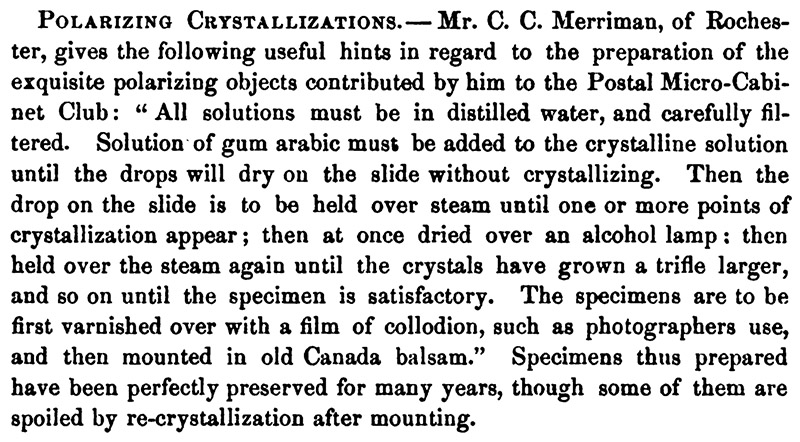
Figure 4.
Slides of chemical crystals by C.C. Merriman, and an 1876 article he wrote on the subject of mounting chemicals for ‘The American Naturalist’.
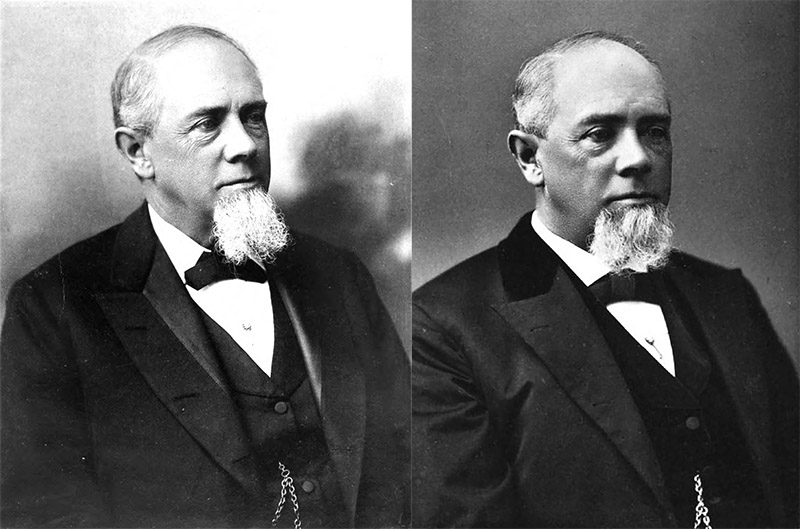
Figure 5.
C.C. Merriman, 1885. Two different photographs appear as frontispieces of different issues of his 1885 book, “Lectures, Essays and Published Articles on Scientific and Literary Subjects and on Foreign Travel”.
C.C. Merriman came from a relatively affluent family, as evidenced by his graduation from Yale University in 1849. Following that, he ventured into a number of different businesses, including law, banking, manufacturing industries, and real estate speculation. To judge from census records, he was a fairly wealthy man throughout life: the 1880 U.S. census listed the 53-year old as a “retired banker” with 3 live-in servants, and the 1900 census listed 4 servants.
The Obituary Records of Yale University summarized Merriman’s professional life thusly, “Corydon Charles Merriman was born June 4, 1827, at Elbridge, N.Y., son of Dr. Titus Merriman, a native of Meriden, Conn., and Polly (Backer) Merriman. After graduation he studied law a year each in Syracuse and Poughkeepsie, N.Y. He then engaged in farming at Skaneateles, N.Y., two years, and from the fall of 1853 until 1858 devoted himself to banking. On account of his health he came back to New England and lived a year at Neponset, Mass.; then spent two years in the manufacture of kerosene oil in Rochester, N.Y., having also petroleum interests in Oil City, Pa., and two years in banking, stockraising, and real estate business in Genesee, Ill.”
While living in Illinois, Merriman registered for the military draft, in 1863. He was listed as “second class”, due to being married and over 35 years old (he was 36), and so did not serve in the U.S. Civil War.
Although Merriman married in 1850, to Lucy J. Vickery, they do not appear to have had any children until 1857. Their first three children died when very young: Louisa (born in 1857, died in 1863), John (born in 1861, died in 1864), and Lucy (born in 1865, died the same year). These were followed by two who survived, Charles (born in 1867) and Augusta (born in 1868). Charles’ middle name was Corydon, giving him the same initials as his father, a source of possible confusion when interpreting records of the father’s and son’s lives.
On a related note, several genealogical web sites mistakenly give our slide-maker the middle name “Cowles”, and list his parents as Ebenezer Cowles Merriman and Louisa Coleman. Contemporary records of our C.C. Merriman confirm that his middle name was Charles, and his parents were named as listed by Yale University.
In 1864, Merriman returned to Rochester, New York, and remained active in business to some extent. In 1866, he and one W.W. Mack purchased D.R. Barton, a manufacturer of edged tools. Merriman sold his interest to Mack in 1877. In 1869, Merriman was awarded a patent for “an Improvement in traction engines, and it consists in producing the traction by feet secured to revolving wheels”.
However, his alumni memorial talks only of Merriman’s recreations after 1864, implying that business was by then of secondary concern. Yale writes, “In 1864 he returned to Rochester and continued there until 1887 occupied with scientific study, particularly in study with the microscope. In 1885 he collected in a volume and published about twenty-five of his essays and lectures”.
Records from this time include an 1869 donation to the Illinois State Microscopical Society, “From C.C. Merriman, Esq., Rochester, New York, 24 slides Algae - admirably mounted under a film of collodion - for the polariscope”, an 1876 short report on mounting crystals for polariscopy (see Figure 3, above), and an 1877 series of notes and exchange offers regarding specimens collected by Merriman while vacationing in Bermuda (see Figure 1, above).
In 1878, he read a paper on “New forms of mounting”, to the National Microscopical Congress, “The cement which is essential to these processes, and which I regard as the most important working material of the microscopist, is shellac varnish prepared in the following simple manner: The white purified gum shellac is dissolved in alcohol and filtered through cotton one or more times until it is quite clear and transparent. As the filtering is to most persons a somewhat difficult operation, they had better perhaps let the druggist make this preparation for them. With this cement I build up a cell as deep and perhaps as quickly as one can be made with a curtain ring, painted up as it usually is. As much as one or two drops can be put on a slide with a brush, using the turn-table, and then slowly worked up into a narrow ring with the point of a small knife-blade held on the turning slide. When this has dried a day or two, another layer can be put on and worked up in the same way. Three or four such layers will be sufficient for almost any cell, and it can then be dried in the heating oven and laid aside for future use.
By carrying along a dozen or two slides at once, one will find great economy both of time and labor. These rings being transparent are admirably adapted for opaque mountings, with which it is desired to use the Lieberkühn.
If common curtain rings are fastened to slides with shellac cement, colored with aniline blue, the joined edges of the brass film of which the ring is made being on the glass, and then subjected to a slowly increasing heat until the cement begins to burn, a very beautiful ornamentation is given to the under side of the ring, a circle of minute golden links making their appearance there. These rings can then be painted according to fancy on the turn-table and used for any kind of mounting.
I use this cement, colored with the various aniline dyes which are soluble in alcohol, for painting and finishing slides. These colors are far superior, for all purposes of ornamentation, to any other material or devices for painting; they dry quickly and adhere to glass with greater tenacity than any other cements that I have ever used.
For a cell that will perfectly withstand the action of Canada balsam or turpentine, I make use of the shellac cement colored with aniline blue, in the following manner: After a cell of the required depth is made on the slide and pretty thoroughly dried in the usual way, it is heated on the heating table, slightly at first in order to avoid bubbles, then gradually increasing the heat until the cement commences to smoke and the color to burn out. By heating one side of the ring a very little more than the other, as may be done over an alcohol lamp, a part may be left blue while the other is yellow or reddish, which has a very pretty effect under Canada balsam. These cells are hard as bone, and can scarcely be cut from the glass. Balsam has no effect whatever on them. Mountings on them may be finished off with liquid balsam, made true and circular with the point of a knife on the turn-table. In a few days, or in a shorter time by using the oven, they will be ready to clean and lay away. The cells which I have described are the only cement cells that can be used with Canada balsam. They are particularly adapted to vegetable stainings, algae, and all other preparations either too thick or too tender to be mounted in balsam without something to sustain the thin glass covers.
In opaque mountings when cements of any kind are used, either for back-ground or to hold the object in place, I have found it highly advantageous to leave on, or in the lower part of the ring, a minute aperture opening into the cell, not necessarily larger than a cambric needle would make. With this provision both the cell and the cement go on drying, and there is no sinking in or moving about of the objects in the medium which holds them. If the cell be hermetically closed, one may expect that the object will, sooner or later, be overwhelmed in a black sea. If curtain rings are used, a little notch can be filed in the side of them, and this be left open when the slide is finished.
If the opaque mountings are for dry objects, I make in the center of the ring a disk of Brunswick black or white zinc, according as the object to be shown is white or black. It may be 5/16 of an inch in diameter for the Lieberkühn of the 1 1/2 inch objective, but not over 1/4 inch for that of the 2/3 objective. After the cement is dry and quite hard, a thin coat of balsam is spread over it and the objects placed in this and arranged if necessary under the microscope. The slide is then set aside to dry and may safely be covered the next day. If the object to be mounted will bear immersion in balsam, as some shells, seeds, minerals, etc., I pursue the following plan: The thin glass covers are cemented to some old slips, kept for the purpose, by two or three touches of the balsam applied to the edge of the cover, care being taken to center the cover on the slip by means of the self centering turntable. The objects are then arranged on a light coating of balsam on the center of the cover. When quite dry they should be completely covered by balsam and thoroughly hardened in the drying oven. Then Brunswick black or white zinc may be spread over the object, in thin layers at first, each being dried in the open air for a day before putting on the next, until an opaque covering is made for the object. Thoroughly clean the cover around the objects and then remove it from the slip by a slight heating. Then turn it over and mount it upon the cell prepared for it. Fasten the cover to the cell with gelatine softened by water to the consistency of jelly and then liquefied by alcohol. Put the cover on the cell and apply the gelatine solution with a brush around the edge, leaving the little opening before referred to. When dry the cell may he finished with liquid balsam, carefully avoiding the little aperture. The outer edge may be gathered up into a neat trim circle with the point of a knife on the turn-table."
The editors of The American Quarterly Microscopical Journal opined, “This method of mounting in balsam on the cover, and backing up with black varnish, deserves to be better known. We have seen some of Mr. Merriman's slides made in this way, and with certain objects such as the Orbiculina and Orbitolites, or Peneropolis from Bermuda sand, there is no method equal to it”.
In 1879, C.C. Merriman was elected to be a Vice President of the American Society of Microscopists. At that year’s conference, he also presented a talk “On the preparation and mounting of double stainings”.
A 3 1/2 page paper by Merriman was published in Science in 1884, on “Microscopical collections in Florida”. In addition to describing various specimens he had collected there, the article gives us some personal information on the man. It begins, “It has been my fortune during the past two Winters to spend a few weeks in the regions of Central Florida. Lake Harris is the most southern and the most beautiful of the cluster of lakes which forms the source of that exceedingly picturesque river, the Ocklawaha”, and ends with a paragraph defending a creationist idea that is now called intelligent design, “I believe in the fact of the gradual development of the organic kingdoms; for all science teaches it. But I believe it was governed and guided by forces more potent than accident or chance. The Being, or the first cause, if you will, that originated the simple elements of matter, and endowed them with the power and the tendency to aggregate into developing worlds, might equally as well have endowed certain of them with the power and the tendency to aggregate into ever advancing organisms. There is no chance, in the myriad forms of crystalline and chemical substances; then why should there be in the scarcely more varied colloid forms of living matter? In a world that unfolds from chaos in one steady line of progress, that shows only design at every advancing stage, I must logically place somewhere at its commencement the Almighty fiat of a Designer”. Having been born and educated before Darwin’s publications on evolution, Merriman’s views show a compromise between his upbringing and his later experiences in science.
In 1885, Merriman self-published a book, collecting 25 of his writings. The subjects run a wide range, from the aforementioned “On the preparation of objects for the microscope” and “Preparation and mounting of double stainings”, to “A trip to Mexico” and “Sight-seeing in New Zealand”, to “Stories of noted paintings”, and “The Huns of Attila”.
According to his Yale record, Merriman moved to Chicago in 1887. The 1900 census listed C.C. and Lucy living with their daughter Augusta, her husband Richard (a “plumber supplier”), and three grandchildren. Lucy died in 1907. C.C. Merriman “died after several years of feebleness, at his country home at Sodus, N.Y., on his birthday, June 4, 1908, at the age of 81 years”.
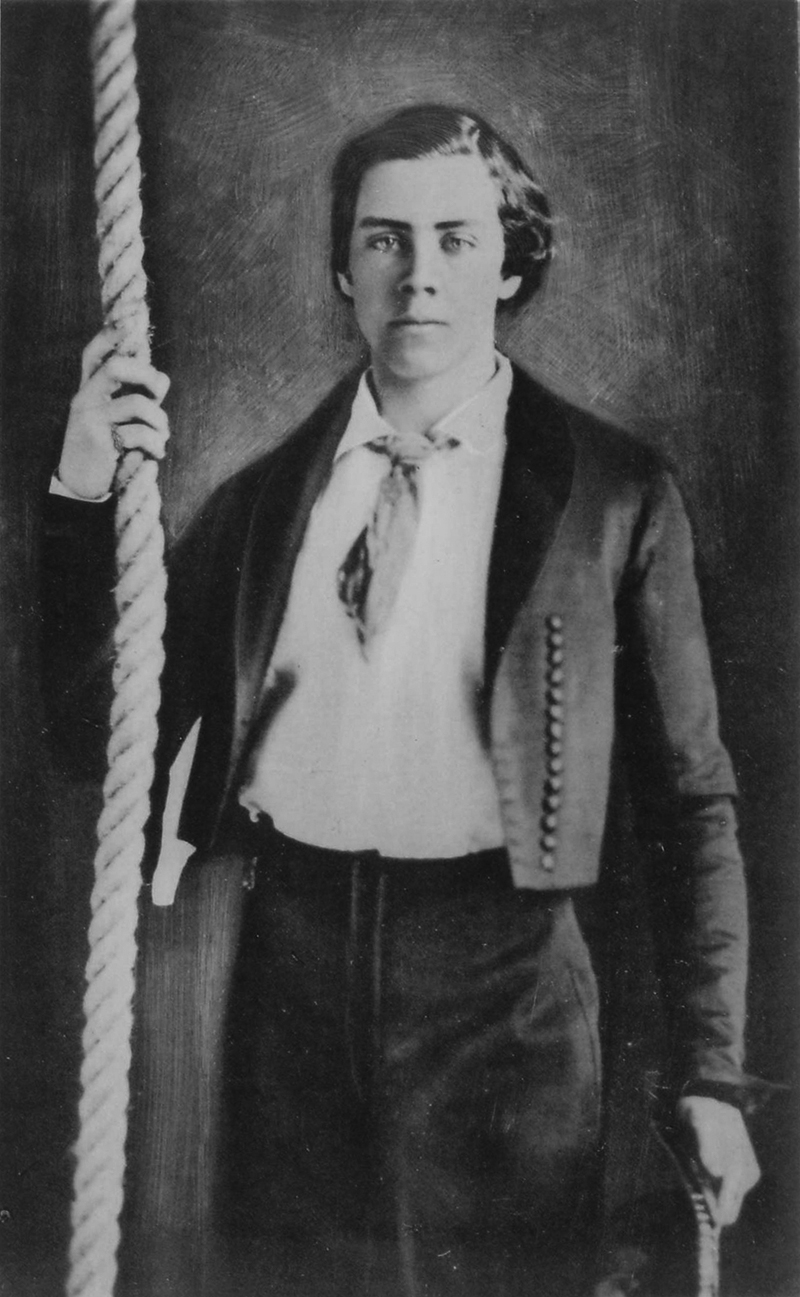
Figure 6.
Copy of an 1847 daguerreotype of C.C. Merriman, “Sailor Boy Charlie”, which accompanied “Sketches of a sea-life” in Merriman’s 1885 “Lectures”. The table of contents summarized, “The story of the author’s first voyage ‘before the mast,’ in the year 1847. It was the new packet ship, St. Denis, from New York to Havre in France. The trip forth and back occupied about four months. It occurred in the writer’s sophomore year at Yale College; but all examinations were afterwards passed and he graduated with his class in ‘49”.
Acknowledgement
Thanks to Steve Gill and Ted Bernhardt for sharing information and pictures.
Resources
The American Naturalist (1876) Polarizing crystallizations, Vol. 10, page 309
The American Naturalist (1877) Shell-sand from the Bermudas, Vol. 11, page 441
The American Naturalist (1879) American Society of Microscopists, Vol. 13, pages 663-664
The American Quarterly Microscopical Journal (1878) The National Microscopical Congress, Vol. 1, pages 63-64
The Dental Cosmos (1869) Illinois State Microscopical Society, Vol. 1, page 364
Draft registration of Corydon C. Merriman (1863) accessed through ancestry.com
History and Commerce of Rochester Illustrated (1894) Mack & Company, A.F. Parson, New York, page 84
Merriman, C.C. (1877) Exchange offer for shell-sand from Bermuda, The American Naturalist, Vol. 11, page 699
Merriman, C.C. (1877) Exchange offer for Bermuda shell sand, The American Naturalist, Vol. 12, pages 839-841
Merriman, C.C. (1878) Microscopical collections in Florida, Science, Vol. 1, pages 263-266
Merriman, C.C. (1880) New forms of mounting, The American Journal of Microscopy and Popular Science, Vol. 2, pages 52, 64, 92, 108, 124, and 172
Merriman, C.C. (1885) Lectures, Essays and Published Articles on Scientific and Literary Subjects and on Foreign Travel, Merriman, Rochester, N.Y.
Obituary Record of Graduates of Yale University (1908) 1849 Corydon Charles Merriman, page 11
Proceedings of the American Society of Microscopists (1884) The Annual Soiree of the Society, in conjunction with the Rochester Academy of Sciences, Vol. 6, page 240
Scientific American (1869) Notice of patent awarded to C.C. Merriman, Oct. 9 issue, page 237
U.S.A. vital records, accessed through ancestry.com